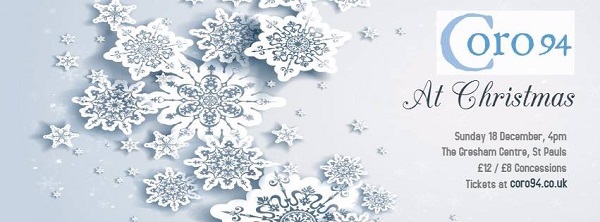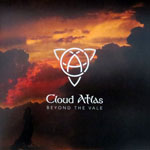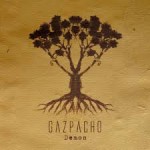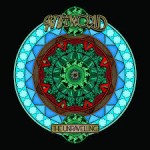As you all ought to know, I’m really a rock reviewer, so this isn’t a conventional review; I’ve written a lot more about myself that is proper for a typical rock review, but feels appropriate to set the rest of the review in context.
Before I discovered rock and roll in my late teens I listened to a lot of classical music. My mum was a member of an amateur choral society, and I sat through their concerts from an early age. I was probably too young to appreciate some of the seemingly interminable oratorios, but the Christmas carol concerts were always entertaining. In more recent years, while living in Cheadle Hulme, I always attended the very traditional Nine Lessons and Carols at the Parish Church, often the last thing I did up north before heading south to spend Christmas with family. That’s something I’m missed the last couple of years; very often I’ve found myself at a gig as a reviewer the last Sunday before Christmas.
So attending a Christmas concert by one of Britain’s top amateur choirs wasn’t so much a step outside my comfort zone as it was a sense of things coming full circle, especially when the choir in question includes Anne-Marie Helder of Panic Room and Luna Rossa, who needs no introduction to to regular readers of this blog.
The concert itself was as beautiful as the building it was held in. They put together a hugely varied program; with a lot of modern classical compositions especially in the first half, alongside an African-American spiritual, an Oregonian folk carol, a traditional number from Botswana as well as well-know carols and secular Christmas songs. Highlights of the first half included “Serenity (O Magnum Mysterium)” by Norwegian-born composer Ola Gjeilo, a piece accompanied by violin and cello, and works best if you close your eyes and let the music waft over you. They followed this with the completely bonkers “Christus Est Natus” by Slovenia’s Damien MoÄnik.
For parts of the concert, Coro94 shared their stage with a children’s choir in the shape of the Fulham Cross Girls’ School Glee Club, a reminder of Coro94′s origins as a youth choir. They performed some numbers on their own, including an arrangement of Sia’s “Chandelier”, and joined Coro94 on others, such as the traditional carol “O Holy Night”.
The second half was more up-tempo with an emphasis on traditional carols, with some audience participation on the ambitiously complicated folk carol “Come and I Will Sing You”. They ended with a couple of well-known secular Christmas songs which came over as something equivalent to prog bands covering 70s standards as Christmas encores.
It’s something a little different from your typical rock gig; as is common in events held in churches. the bar served wine but not beer. But much like some contemporary folk or jazz there was nothing that shouldn’t be accessible to a more open-minded progressive rock fan; the Gjeilo piece in particular had a strong Iamthemorning feel about it. It makes me wonder how much being steeped in classical and choral music from an early age has influenced Anne-Marie Helder’s subsequent songwriting, and whether that explains something of why I love her music.












 Yet another York-based band (Is there something in the water?), Cloud Atlas is the band put together by Heidi Widdop following the dissolution of Stolen Earth. Their impressive début album is big widescreen rock with an epic scope, with Heidi’s distinctive bluesy vocals setting them apart from many of their obvious peers. But this album’s sound is as much about Martin Ledger’s soaring melodic lead guitar, with strong echoes of Marillion’s Steve Rothery.
Yet another York-based band (Is there something in the water?), Cloud Atlas is the band put together by Heidi Widdop following the dissolution of Stolen Earth. Their impressive début album is big widescreen rock with an epic scope, with Heidi’s distinctive bluesy vocals setting them apart from many of their obvious peers. But this album’s sound is as much about Martin Ledger’s soaring melodic lead guitar, with strong echoes of Marillion’s Steve Rothery. Norway’s Gazpacho have come up with one of the darkest and most sinister-sounding records of 2014. It’s what Talk Talk’s Spirit of Eden might have sounded like if Mark Hollis had spent a lot of time listening to Black Sabbath. Sinister violin-led pastoral soundscapes with are intercut with bursts of hard rock, motifs recur across the album, and there’s even an irruption of accordion-led central European folk at one point. An ambitious album which is by no means an easy listen, but one where you can keep finding new layers after many listens.
Norway’s Gazpacho have come up with one of the darkest and most sinister-sounding records of 2014. It’s what Talk Talk’s Spirit of Eden might have sounded like if Mark Hollis had spent a lot of time listening to Black Sabbath. Sinister violin-led pastoral soundscapes with are intercut with bursts of hard rock, motifs recur across the album, and there’s even an irruption of accordion-led central European folk at one point. An ambitious album which is by no means an easy listen, but one where you can keep finding new layers after many listens. A major step forward for Kavus Torabi’s eight-piece band, and reflects their current live sound far more than any of their previous recordings. It’s a record that takes psychedelia, jazz, hard rock and all kinds of other things, and puts them in a blender to produce something that sounds quite unlike anyone else. Fans of the late, great Frank Zappa should find a lot to like about this record, as should anyone who thinks there should be more bassoons in rock.
A major step forward for Kavus Torabi’s eight-piece band, and reflects their current live sound far more than any of their previous recordings. It’s a record that takes psychedelia, jazz, hard rock and all kinds of other things, and puts them in a blender to produce something that sounds quite unlike anyone else. Fans of the late, great Frank Zappa should find a lot to like about this record, as should anyone who thinks there should be more bassoons in rock. Luna Rossa started out as a side-project from Panic Room emphasising the acoustic side of Anne-Marie Helder’s and Jon Edwards’ music, but seems to have taken on a life of it’s own. Their second album is a logical progression from the first; perhaps not quite as eclectic, but with a slightly clearer musical identity. Luna Rossa still defy easy genre pigeonholing, though the album does show occasional hints of artists as varied as Goldfrapp and Renaissance. There’s some very raw heart-on-sleeve emotion, with the music revolving around and complementing Anne-Marie’s always remarkable vocals.
Luna Rossa started out as a side-project from Panic Room emphasising the acoustic side of Anne-Marie Helder’s and Jon Edwards’ music, but seems to have taken on a life of it’s own. Their second album is a logical progression from the first; perhaps not quite as eclectic, but with a slightly clearer musical identity. Luna Rossa still defy easy genre pigeonholing, though the album does show occasional hints of artists as varied as Goldfrapp and Renaissance. There’s some very raw heart-on-sleeve emotion, with the music revolving around and complementing Anne-Marie’s always remarkable vocals. This Kickstarter-funded project is Steve Rothery’s first proper solo album in more than three decades as lead guitarist of Marillion. It’s an instrumental album with a band including Panic Room’s Yatim Halimi and Mr So and So’s Dave Foster, Rothery’s lyrical and emotional playing both soars and rocks, the numbers building in intensity from slow-burning beginnings. The whole thing shows just why Rothery is one of the best guitarists of his generation, one of the few players good enough to pull this sort of thing off without descending into self-indulgence.
This Kickstarter-funded project is Steve Rothery’s first proper solo album in more than three decades as lead guitarist of Marillion. It’s an instrumental album with a band including Panic Room’s Yatim Halimi and Mr So and So’s Dave Foster, Rothery’s lyrical and emotional playing both soars and rocks, the numbers building in intensity from slow-burning beginnings. The whole thing shows just why Rothery is one of the best guitarists of his generation, one of the few players good enough to pull this sort of thing off without descending into self-indulgence.


